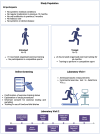A comparison of oral microbiome composition between highly trained competitive athletes and untrained controls
- PMID: 40877538
- PMCID: PMC12394404
- DOI: 10.1038/s41598-025-16835-3
A comparison of oral microbiome composition between highly trained competitive athletes and untrained controls
Abstract
The oral microbiome has a crucial role in nitric oxide (NO) production and contributes to oral and systemic health. This study compared oral microbiome composition and markers of NO production between highlytrained competitive athletes and inactive controls. Competitive athletes and untrained controls (N = 10 per group) were recruited. Saliva, plasma, supragingival plaque and the tongue dorsum microbiome were sampled. The microbiome was examined using long-read 16S rRNA sequencing and ozone-based chemiluminescence used to measure nitrate (NO3-) and nitrite (NO2-) levels. Weekly training duration was recorded and aerobic fitness capacity (V̇O2max) assessed via maximal exercise testing.The beta-diversity of the tongue dorsum microbiome differed between groups (Adonis p = 0.046) and athletes had a higher relative abundance of NO3--reducing Rothia mucilaginosa and unclassified Gemella species. No significant differences were detected in the supragingival plaque. Positive correlations were detected between R. mucilaginosa and unclassified Gemella species and aerobic fitness. Athletes had higher levels of salivary NO3- (p = 0.003) and NO2- (p = 0.03). Exercise training may impact the tongue dorsum microbiome more than supragingival plaque, with the relative abundance of specific health-associated bacteria higher in the tongue dorsum microbiome of athletes. The robust methodologies employed in this study highlight a possible link between consistent exercise and the development of an oral microbiome conducive to health. However, further research is needed to explore the mechanisms connecting exercise, the oral microbiome, and overall health.
Keywords: 16 s rRNA; Dental disease; Exercise; Exercise training; Nitrate; Nitrate-reduction; Nitric oxide; Nitrite-production; Oral microbiome; Physical activity.
© 2025. The Author(s).
Conflict of interest statement
Declarations. Competing interests: A.M. and B.T. Rosier are coinventors in a pending patent application owned by the FISABIO Institute, which protects the use of NO3- as a prebiotic and certain NO3–reducing bacteria as probiotics. The remaining authors declare no competing interests. Ethical approval: The study was approved by the School of Health and Life Sciences Research Ethics Committee at the University of the West of Scotland (submission number 14970). With the exception of pre-recruitment trial registration, all procedures were carried out in accordance with the World Medical Association Declaration of Helsinki. All participants gave written informed consent.
Figures








Similar articles
-
Oral bacterial community dynamics during induction of gingival inflammation.Front Cell Infect Microbiol. 2025 Jun 16;15:1597690. doi: 10.3389/fcimb.2025.1597690. eCollection 2025. Front Cell Infect Microbiol. 2025. PMID: 40589868 Free PMC article.
-
Eight weeks of high-intensity interval training alters the tongue microbiome and impacts nitrate and nitrite levels in previously sedentary men.Free Radic Biol Med. 2025 Apr;231:11-22. doi: 10.1016/j.freeradbiomed.2025.02.006. Epub 2025 Feb 7. Free Radic Biol Med. 2025. PMID: 39923866
-
Microbial signatures in oral sites of patients with primary Sjögren's syndrome: Association with salivary gland hypofunction.J Microbiol. 2025 Jun;63(6):e2501030. doi: 10.71150/jm.2501030. Epub 2025 Jun 30. J Microbiol. 2025. PMID: 40598993
-
NO: a key player in microbiome dynamics and cancer pathogenesis.Front Cell Infect Microbiol. 2025 Jun 26;15:1532255. doi: 10.3389/fcimb.2025.1532255. eCollection 2025. Front Cell Infect Microbiol. 2025. PMID: 40642105 Free PMC article. Review.
-
Physical exercise training interventions for children and young adults during and after treatment for childhood cancer.Cochrane Database Syst Rev. 2016 Mar 31;3(3):CD008796. doi: 10.1002/14651858.CD008796.pub3. Cochrane Database Syst Rev. 2016. PMID: 27030386 Free PMC article.
References
-
- Jones, A. M. et al. Dietary nitrate and nitric oxide metabolism: mouth, circulation, skeletal muscle, and exercise performance. Med. Sci. Sports Exerc.53(2), 280. 10.1249/MSS.0000000000002470 (2021). - PubMed
-
- Lundberg, J. O., Carlström, M. & Weitzberg, E. Metabolic effects of dietary nitrate in health and disease. Cell Metab.28(1), 9–22. 10.1016/j.cmet.2018.06.007 (2018). - PubMed
Publication types
MeSH terms
Substances
Grants and funding
LinkOut - more resources
Full Text Sources

